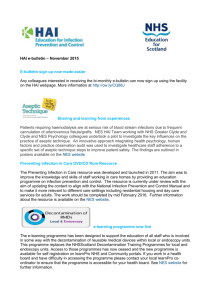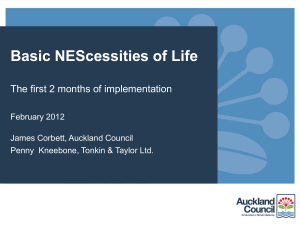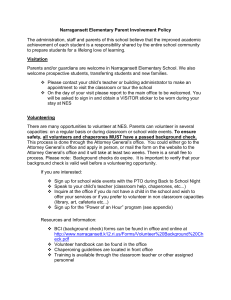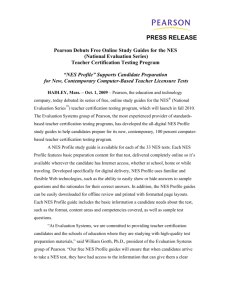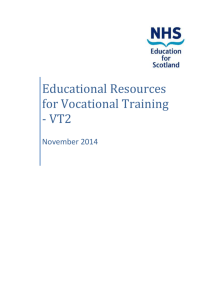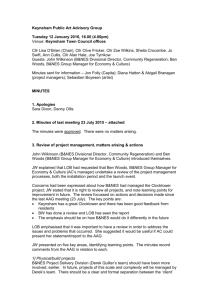Some examples – Mitiamo Rail Reserve
advertisement
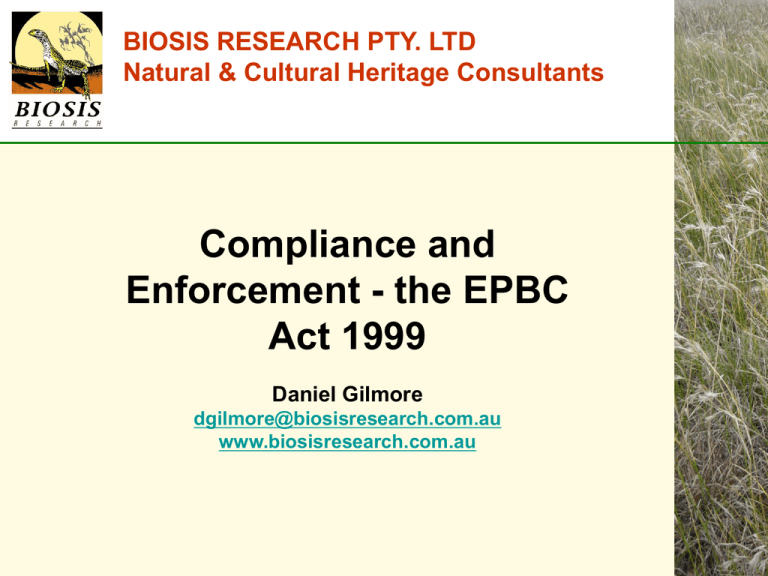
BIOSIS RESEARCH PTY. LTD Natural & Cultural Heritage Consultants Compliance and Enforcement - the EPBC Act 1999 Daniel Gilmore dgilmore@biosisresearch.com.au www.biosisresearch.com.au Introduction EPBC Act is a powerful piece of legislation which aims to protect Matters of NES. Much stronger than Victorian State biodiversity legislation (FFG Act). Consequences of breaching the Act can be substantial including civil penalties of up to $550K for individuals and $5.5M for companies and 7 years imprisonment. A number of Options available to the Minister for penalizing a breach of the Act – most often Enforceable Undertakings, Civil and Criminal penalties and Remediation of Damage. Contraventions can be publicised by the Minister – not a good look. How is a potential breach of the Act determined? Potential breaches of the Act can be reported to the Department from the public, NGOs or government agencies. When a potential breach of the Act has occurred, independent advice often sought by the Department or the proponent on whether the action has had or is likely to have had a significant impact on a matter of NES. Consultant ecologists often engaged to inspect the alleged impacts and make a determination using existing information, significant impact guidelines, Policy Statements and expert opinion. Site inspections by Departmental Compliance Officers. Compliance audits for approved projects. Some examples – Mitiamo Rail Reserve Firebreak grading on rail reserve by independent contractor – known population of Spiny Rice-flower (critically endangered). Alleged impact on Spiny Rice-flower. Engaged to determine nature and extent of impacts. Site inspection. Review of existing information for the site: Previous reports Population monitoring information (DSE) FIS data Pre-clearing photographs Some examples – Mitiamo Rail Reserve Pegs marking boundary of established monitoring quadrats were still evident. As the number of plants for the site had been previously documented, we counted the number of plants remaining to estimate how many were lost. Significant impact threshold in Policy Statement is loss of more than 5 plants. Based on independent advice Department concluded somewhere between 23 and 38 plants lost. Consistent with our findings. Some examples – Mitiamo Rail Reserve Department found that the firebreak is likely to have had a significant impact on the species. Relatively straightforward assessment as there was preexisting population data. Significant Impact thresholds available for this species. Highlights the importance of having pre-existing information to determine the number of plants killed (i.e. whether the action had a significant impact on Spiny Rice-flower). Plants are sedentary and relatively easy to survey for compared to many listed animals for which lengthy and expensive surveys are often required. Some examples – Reid Street Ardeer Involved the clearing of native vegetation for the stockpiling of industrial materials and machinery. Site known to support NTGVVP, Striped Legless Lizard (SLL) and Spiny Rice-flower (SRF). Previous reports on the distribution and abundance of these species and communities in relation to the affected area. Stockpiling on a tile grid used to monitor SLL and where a population had been recorded previously. From this information it was established that there were impacts to NTGVVP as well as individuals of and habitat for SLL and SRF. Some cases are more difficult More difficult to establish extent or nature of impacts for situations where pre-existing conditions were not known (e.g. hard to determine if the matter of NES was present). For most listed species and communities significant impact thresholds not available – have to use the broader significant impact guidelines and expert opinion to determine impact. Hard to determine the importance of sites for highly mobile species (Swift Parrot) or ephemeral species that might not be evident during a site inspection (habitat used as a surrogate). For vulnerable species, the impact is generally only considered to be significant if it affects an ‘important’ population – differing opinions on what constitutes an important population. Remember – it doesn’t take much to breach the Act Seemingly benign actions can be significant. In Geelong a company cleared 0.8 ha of NTGVVP– deemed to be a significant impact – Enforceable Undertaking $131K for rehabilitation and review of works programs. A company removed rocks from 0.4 ha of NTGVVP in Altona – deemed a significant impact - Enforceable Undertaking $62K paid to DSE for grassland research and rehabilitation and commitment to conserving 13 ha of the listed community. Ardeer – stockpiled materials on a relatively small area of SLL habitat but deemed an important population – Enforceable undertaking - $30K to the SLL Recovery Team and $170K to DSE. Melbourne – Matters of NES are everywhere! Three listed ecological communities are found in Melbourne’s north and west, two of which are widespread – NTGVVP and GEWVVP. Listed grassland and grassy woodland species (GSM, SLL, GGF, MFL, SRF) all widespread and persist in degraded and isolated sites. Ramsar Wetlands (Port Phillip Bay and Westernport, Seaford-Edithvale Wetlands). Southern Brown Bandicoot in Melbourne’s south-east occurs in roadside remnants and agricultural areas. Many actions have the potential to impact on listed species and communities as Melbourne grows. How to avoid contravening the Act Do your homework and get expert advice – use the PMST to see if and what Matters of NES could occur on or near the site of your proposed action. Be mindful that many species and communities occur in alienated and degraded land where you might not expect a threatened species to occur. Read the significant impact guidelines and species policy statements – it does not take much to reach significant thresholds for many species and communities. Refer any actions for which a significant impact is likely. If unsure, refer anyway! How to avoid contravening the Act If an impact to a matter of NES is likely, consider how it can be avoided or minimised – think outside the square and avoid the pain! Remember you may be audited so keep records of all activities and remember to comply with EPBC approval conditions if your action is a controlled action or NCA if undertaken in a specified manner. The damage happens on the ground so maintain good communication with contractors and make sure they are aware of matters of NES in the area of concern. Ask an expert. If in doubt use a consultant to determine if matters of NES may be affected by your action. If all else fails… If you stuff up, fess up. Hiding information or failure to report breaches of the Act are not likely to be viewed favorably by the Department of SEWPaC.



